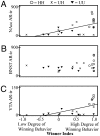Winning territorial disputes selectively enhances androgen sensitivity in neural pathways related to motivation and social aggression
- PMID: 20616093
- PMCID: PMC2901436
- DOI: 10.1073/pnas.1001394107
Winning territorial disputes selectively enhances androgen sensitivity in neural pathways related to motivation and social aggression
Abstract
Winning aggressive disputes can enhance future fighting ability and the desire to seek out additional contests. In some instances, these effects are long lasting and vary in response to the physical location of a fight. Thus, in principle, winning aggressive encounters may cause long-term and context-dependent changes to brain areas that control the output of antagonistic behavior or the motivation to fight (or both). We examined this issue in the territorial California mouse (Peromyscus californicus) because males of this species are more likely to win fights after accruing victories in their home territory but not after accruing victories in unfamiliar locations. Using immunocytochemistry and real-time quantitative PCR, we found that winning fights either at home or away increases the expression of androgen receptors (AR) in the medial anterior bed nucleus of the stria terminalis, a key brain area that controls social aggression. We also found that AR expression in brain regions that mediate motivation and reward, nucleus accumbens (NAcc) and ventral tegmental area (VTA), increases only in response to fights in the home territory. These effects of winning were likely exclusive to the neural androgenic system because they have no detectible impact on the expression of progestin receptors. Finally, we demonstrated that the observed changes in androgen sensitivity in the NAcc and VTA are positively associated with the ability to win aggressive contests. Thus, winning fights can change brain phenotype in a manner that likely promotes future victory and possibly primes neural circuits that motivate individuals to fight.
Conflict of interest statement
The authors declare no conflict of interest.
Figures




Similar articles
-
Independent and additive contributions of postvictory testosterone and social experience to the development of the winner effect.Endocrinology. 2011 Sep;152(9):3422-9. doi: 10.1210/en.2011-1099. Epub 2011 Jul 19. Endocrinology. 2011. PMID: 21771886
-
Opposing hormonal mechanisms of aggression revealed through short-lived testosterone manipulations and multiple winning experiences.Horm Behav. 2004 Feb;45(2):115-21. doi: 10.1016/j.yhbeh.2003.09.006. Horm Behav. 2004. PMID: 15019798
-
Winning fights elevates testosterone levels in California mice and enhances future ability to win fights.Horm Behav. 2005 Sep;48(3):259-67. doi: 10.1016/j.yhbeh.2005.04.007. Horm Behav. 2005. PMID: 15979073
-
What can animal research tell us about the link between androgens and social competition in humans?Horm Behav. 2017 Jun;92:182-189. doi: 10.1016/j.yhbeh.2016.11.014. Epub 2016 Dec 1. Horm Behav. 2017. PMID: 27914879 Review.
-
The challenge hypothesis revisited: Focus on reproductive experience and neural mechanisms.Horm Behav. 2020 Jul;123:104645. doi: 10.1016/j.yhbeh.2019.104645. Epub 2019 Dec 16. Horm Behav. 2020. PMID: 31778720 Review.
Cited by
-
Anxiety induces long-term memory forgetting in the crayfish.J Comp Physiol A Neuroethol Sens Neural Behav Physiol. 2021 Jul;207(4):459-467. doi: 10.1007/s00359-021-01487-1. Epub 2021 Apr 21. J Comp Physiol A Neuroethol Sens Neural Behav Physiol. 2021. PMID: 33881581
-
Exogenous testosterone increases the audience effect in healthy males: evidence for the social status hypothesis.Proc Biol Sci. 2020 Jul 29;287(1931):20200976. doi: 10.1098/rspb.2020.0976. Epub 2020 Jul 15. Proc Biol Sci. 2020. PMID: 32673552 Free PMC article.
-
How research on female vertebrates contributes to an expanded challenge hypothesis.Horm Behav. 2020 Jul;123:104565. doi: 10.1016/j.yhbeh.2019.104565. Epub 2019 Sep 10. Horm Behav. 2020. PMID: 31419407 Free PMC article. Review.
-
Female marmosets' behavioral and hormonal responses to unfamiliar intruders.Am J Primatol. 2011 Oct;73(10):1072-81. doi: 10.1002/ajp.20975. Epub 2011 Jul 11. Am J Primatol. 2011. PMID: 21748772 Free PMC article.
-
Neurobiology of Aggression-Review of Recent Findings and Relationship with Alcohol and Trauma.Biology (Basel). 2023 Mar 20;12(3):469. doi: 10.3390/biology12030469. Biology (Basel). 2023. PMID: 36979161 Free PMC article. Review.
References
-
- Oliveira RF. Social behavior in context: Hormonal modulation of behavioral plasticity and social competence. Integr Comp Biol. 2009;49:423–440. - PubMed
-
- Amorim MC, Almada VC. The outcome of male-male encounters affects subsequent sound production during courtship in the cichlid fish Oreochromis mossambicus. Anim Behav. 2005;69:595–601.
Publication types
MeSH terms
Substances
Grants and funding
LinkOut - more resources
Full Text Sources
Other Literature Sources
Research Materials
Miscellaneous

